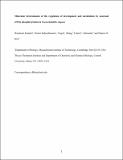Molecular Determinants of the Regulation of Development and Metabolism by Neuronal eIF2α Phosphorylation in
Author(s)
Zhang, Ying K.; Schroeder, Frank C.; Kulalert, Warakorn; Sadeeshkumar, Harini; Kim, Dennis H.
DownloadKulalert_Kim.pdf (9.904Mb)
OPEN_ACCESS_POLICY
Open Access Policy
Creative Commons Attribution-Noncommercial-Share Alike
Terms of use
Metadata
Show full item recordAbstract
Cell-nonautonomous effects of signaling in the nervous system of animals can influence diverse aspects of organismal physiology. We previously showed that phosphorylation of Ser49 of the α-subunit of eukaryotic translation initiation factor 2 (eIF2α) in two chemosensory neurons by PEK-1/PERK promotes entry of Caenorhabditis elegans into dauer diapause. Here, we identified and characterized the molecular determinants that confer sensitivity to effects of neuronal eIF2α phosphorylation on development and physiology of C. elegans. Isolation and characterization of mutations in eif-2Ba encoding the α-subunit of eIF2B support a conserved role, previously established by studies in yeast, for eIF2Bα in providing a binding site for phosphorylated eIF2α to inhibit the exchange factor eIF2B catalytic activity that is required for translation initiation. We also identified a mutation in eif-2c, encoding the γ-subunit of eIF2, which confers insensitivity to the effects of phosphorylated eIF2α while also altering the requirement for eIF2Bγ. In addition, we show that constitutive expression of eIF2α carrying a phosphomimetic S49D mutation in the ASI pair of sensory neurons confers dramatic effects on growth, metabolism, and reproduction in adult transgenic animals, phenocopying systemic responses to starvation. Furthermore, we show that constitutive expression of eIF2α carrying a phosphomimetic S49D mutation in the ASI neurons enhances dauer entry through bypassing the requirement for nutritionally deficient conditions. Our data suggest that the state of eIF2α phosphorylation in the ASI sensory neuron pair may modulate internal nutrient sensing and signaling pathways, with corresponding organismal effects on development and metabolism. Keywords: Caenorhabditis elegans; Dauer; EIF2α; phosphorylation; sensory neurons; translational control
Date issued
2017-05Department
Massachusetts Institute of Technology. Department of BiologyJournal
Genetics
Publisher
Genetics Society of America
Citation
Kulalert, Warakorn et al. “Molecular Determinants of the Regulation of Development and Metabolism by Neuronal eIF2α Phosphorylation inCaenorhabditis Elegans.” Genetics 206, 1 (March 2017): 251–263 © 2017 Genetics Society of America
Version: Author's final manuscript
ISSN
0016-6731
1943-2631